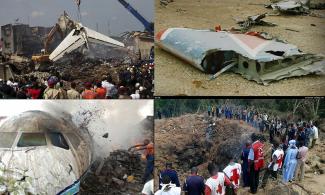
On December 10, 2005, 108 people, mostly students of Loyola Jesuit College in Abuja, were killed after a McDonnell-Douglas operated by Sossoliso Airlines crashed while landing at the Port Harcourt airport.

Nigeria has suffered several terrible accidents, most of which are roads. Meanwhile, some air accidents have left the country with deep scars.
Here is a look 10 air crashes that shook Nigeria.

1. On November 20, 1969, 87 people lost their lives in a Vickers VC-10 Airplane which crashed in Lagos, Nigeria.
The VC-10 took off from London to Lagos with a stopover at Rome and Kano. Upon approaching Lagos, the VC-10 descended below the normal approach path and struck trees.
The aircraft crashed and caught fire.

2. On January 22, 1973, a Boeing 707 chartered by Nigeria Airways to fly pilgrims back from Jeddah to Lagos crashed in Kano and killed 176 people.
Due to inclement weather in Lagos, the flight was diverted to Kano. The aircraft touched nose-wheel first and then collapsed along the runway centre line. Two crew members and 23 occupants were rescued alive.

3. On July 11, 1991, 261 people died after a McDonnell-Douglas DC-8 aircraft flying hajj pilgrims to Sokoto on behalf of the defunct Nigeria Airways, crashed in Jeddah, Saudi Arabia, in the worst accident in the history of commercial aviation in Nigeria.
The Nigeria Airways flight took off from Jeddah runway but shortly after take-off, at 2000-3000 feet, problems with the cabin pressure were reported.
These reports were quickly followed by a burst tire and loss of hydraulics. The aircraft lost control and crashed in flames while trying to return. It was the worst accident involving a DC-8 and the second worst accident in Saudi Arabia at the time.
The root cause of the flight was blamed on human errors at the Nigerian aviation system.

4. On September 26, 1992, 158 occupants died after Lockheed C-130H Hercules operated by Nigerian Airforce crashed near Lagos.
After take-off, one engine failed, followed by a second engine shortly afterward. The crew tried to ditch the aeroplane into the Ejigbo canal, but then a third engine failed again.
The Hercules crashed, nose-down into the swamp. The exact number of casualties is uncertain. But at least 150 Nigerians, five Ghanaians, one Tanzanian, one Zimbabwean, and one Ugandan were involved.

5. On November 7, 1996, a total of 144 people died after a Boeing 727 operated by ADC airline took off from Port Harcourt to Lagos and crashed in Ejirin in Epe, killing all its occupants.
The aircraft crashed after it lost control during an evasive action maneuver. The pilot’s attempt to avoid a head-on collision with another aircraft failed. The aircraft crashed and disintegrated on impact.
“The untidy traffic separation by the radar controller” was the immediate cause of the crash, investigations later revealed.

6. On May 4, 2002, 72 people died after a BAC One-Eleven jet on a flight from Jos to Lagos via Kano, crashed shortly after take-off from Kano airport.
The Aviation Safety Network reported: “Shortly after departing Kano, the aircraft reportedly stalled. It came down in the heavily populated district of Gwammaja about half a mile from the airport on the outskirts of Kano.
It sheared roofs from two-story concrete homes and sliced a mosque in half as it broke apart and burst into flames. Some 23 houses in Gwammaja area were destroyed, along with a school and the mosque."
Moments before the crash, the aircraft had been reportedly grounded for 52 days because of engine problems. It crashed 10 hours after another engine, from another grounded plane was fitted into it.
After the crash, the aviation ministry issued a ban on all aircraft in Nigeria, older than 22 years.

7. On October 22, 2005, 117 people died after a Boeing 737 operated by Bellview Airline crashed near Lagos.
The Bellview flight 210 took off from Lagos at 20:35 for a domestic flight to Abuja.
Tower lost radio contact with the flight about three minutes after take-off. The next morning, the wreckage was found about 30km north of Lagos.
Bad weather was blamed for the crash.

8. On December 10, 2005, 108 people, mostly students of Loyola Jesuit College in Abuja, were killed after a McDonnell-Douglas operated by Sossoliso Airlines crashed while landing at the Port Harcourt airport. Two occupants were rescued alive.
The major reason that caused the crash was bad weather.
An investigative report had said “the crew’s decision to continue the approach beyond the decision altitude without having the runway and/or airport in sight” was the immediate cause of the crash.
Other causes were dysfunctional runway lighting and poor airport design.
9. On October 29, 2006, a total number of 97 people lost their lives after a Boeing 737 operated by ADC Airlines crashed near the Abuja airport a few minutes after take-off.
The ADC Airlines flight departed Lagos on a scheduled domestic flight to Sokoto with an intermediate stop at Abuja.
Immediately after take-off from the Abuja airport, the Boeing 737 contacted the ground, broke up and caught fire in a corn field. A woman working on the field was reportedly killed after being struck by debris from the crash.
The primary cause of the crash was bad weather but the immediate cause was the pilot’s refusal to acknowledge prevailing weather conditions.

10. On June 3, 2012, a Dana aircraft crashed and killed 153 occupants.
A McDonnell Douglas MD-83 passenger plane, 5N-RAM, operated by Dana Air was destroyed when it crashed into a residential area of Lagos.
All 146 passengers and seven crew members were killed. At least, six victims were found inside the buildings that were hit by the plane.